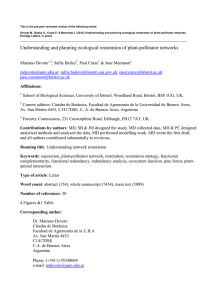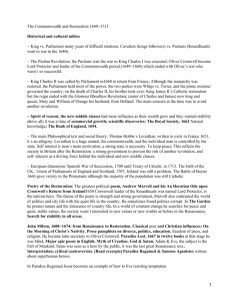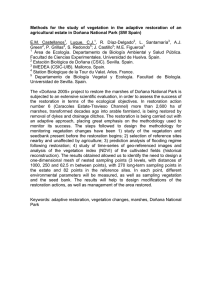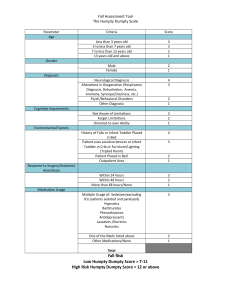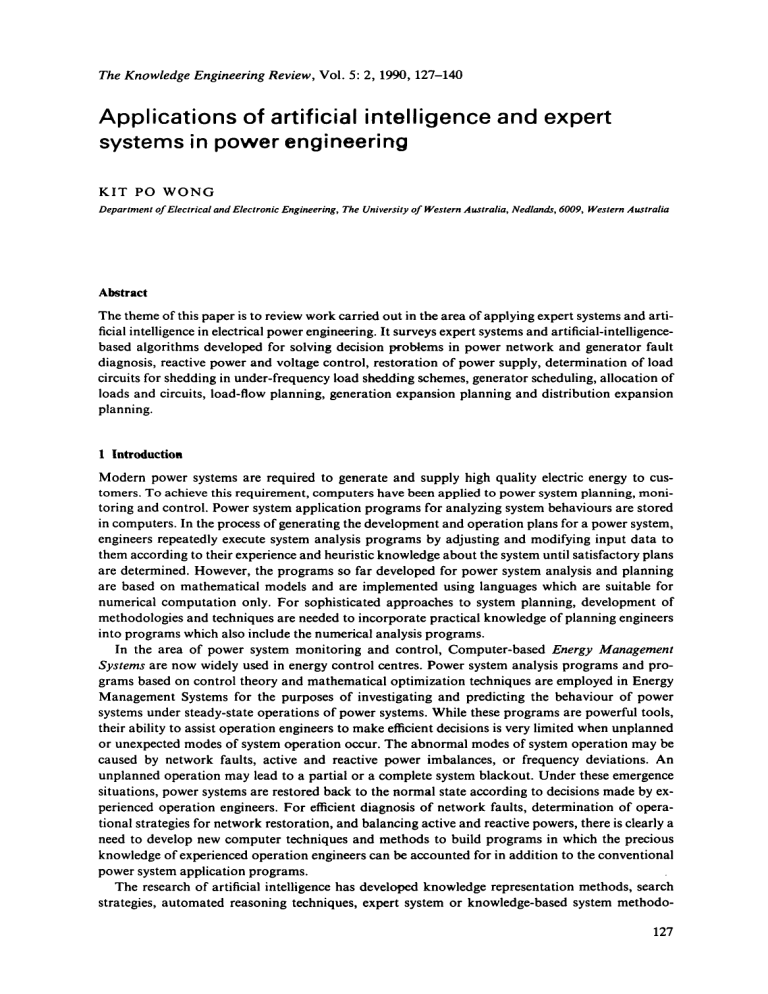
The Knowledge Engineering Review, Vol. 5: 2, 1990,127-140 Applications of artificial intelligence and expert systems in power engineering KIT PO WONG Department of Electrical and Electronic Engineering, The University of Western Australia, Nedlands, 6009, Western Australia Abstract The theme of this paper is to review work carried out in the area of applying expert systems and artificial intelligence in electrical power engineering. It surveys expert systems and artificial-intelligencebased algorithms developed for solving decision problems in power network and generator fault diagnosis, reactive power and voltage control, restoration of power supply, determination of load circuits for shedding in under-frequency load shedding schemes, generator scheduling, allocation of loads and circuits, load-flow planning, generation expansion planning and distribution expansion planning. 1 Introduction Modern power systems are required to generate and supply high quality electric energy to customers. To achieve this requirement, computers have been applied to power system planning, monitoring and control. Power system application programs for analyzing system behaviours are stored in computers. In the process of generating the development and operation plans for a power system, engineers repeatedly execute system analysis programs by adjusting and modifying input data to them according to their experience and heuristic knowledge about the system until satisfactory plans are determined. However, the programs so far developed for power system analysis and planning are based on mathematical models and are implemented using languages which are suitable for numerical computation only. For sophisticated approaches to system planning, development of methodologies and techniques are needed to incorporate practical knowledge of planning engineers into programs which also include the numerical analysis programs. In the area of power system monitoring and control, Computer-based Energy Management Systems are now widely used in energy control centres. Power system analysis programs and programs based on control theory and mathematical optimization techniques are employed in Energy Management Systems for the purposes of investigating and predicting the behaviour of power systems under steady-state operations of power systems. While these programs are powerful tools, their ability to assist operation engineers to make efficient decisions is very limited when unplanned or unexpected modes of system operation occur. The abnormal modes of system operation may be caused by network faults, active and reactive power imbalances, or frequency deviations. An unplanned operation may lead to a partial or a complete system blackout. Under these emergence situations, power systems are restored back to the normal state according to decisions made by experienced operation engineers. For efficient diagnosis of network faults, determination of operational strategies for network restoration, and balancing active and reactive powers, there is clearly a need to develop new computer techniques and methods to build programs in which the precious knowledge of experienced operation engineers can be accounted for in addition to the conventional power system application programs. The research of artificial intelligence has developed knowledge representation methods, search strategies, automated reasoning techniques, expert system or knowledge-based system methodo127 KIT PO WONG 128 logy, and languages for symbolic and list processing. The artificial intelligence techniques and the expert system approach provide power engineers with new tools to augment numeric programs with their experience and heuristic knowledge. In the area of fault diagnosis and control of nuclear power plants, some work have been reported by Nelson (1982), Underwood (1982), Cain (1985) and a survey of the applications of artificial intelligence in the nuclear industry in USA has been given by Uhrig (1987). The possible applications of artificial intelligence to power system operations have been investigated by Schulte et al. (1987) and Wollenberg & Sakaguchi (1987). The feasibility of applying expert systems for handling alarms in power system control centres have been studied by Wollenberg (1985), DeMontravel (1986), Hein (1986) and Kaninsono (1986). This paper surveys work carried out in building expert systems and in developing artificial-intelligenced-based algorithms by power system research workers for solving decision problems in electric power system planning, operation and control. These problems include network and generator fault diagnosis, reactive power and voltage control, restoration of power supply, determination of load circuits for shedding in under-frequency load shedding schemes, generator scheduling, allocation of loads and circuits, load-flow planning, generation expansion planning and distribution expansion planning. 2 Fault diagnosis One application of artificial intelligence and expert systems in power is in the area of power network and generator fault diagnosis. The following sections review some of the systems developed for locating faults in high-voltage and distribution networks, and in turbine-generators. 2.1 High-voltage network systems 2.1.1 The blackboard approach Talukdar et al. (1985, 1986) developed an expert system called TOAST for diagnosing high-voltage network faults. In TOAST, a distributed problem solving approach and the blackboard model are employed. Problem-solvers for diagnosing network faults can communicate through the blackboard of the system. Also through the blackboard, power system operators may interact with a number of programmed problem-solvers consisting of the economic-dispatchers, state-estimators and loadflows for decision making in a power control centre. There are three different problem-solvers in TOAST: the Discrete Event Simulator, the Diagnostician and the Matcher. Given the pre-faulted configuration of a power network and a disturbance, the Discrete Event Simulator predicts the train of events as the result of the disturbance and the post-fault network configuration. To make the prediction possible, knowledge about the protection of the network including misoperating schemes, primary and back-up protection schemes and the effects of the protection signal path are encoded in the simulator. The simulator also contains information about the protected network, a clock, an event calendar and a demon. The clock's unit of time is 1/60 s. The event calendar contains an automatically compiled list of times at which events are expected to happen in the network. The demon is designed to modify the descriptions of network devices to simulate misoperations. This simulator has about 250 production rules and is implemented in OPS5 (Brownston et al., 1986). The Diagnostician in TOAST is an expert system which suggests different possible causes for a fault and ranks them according to their likelihood for a given pre-fault and final states of the circuitbreakers and relays in the network. It is a rule-based system written in OPS5 with about 150 rules. The third problem-solver of TOAST is the Matcher. It verifies the hypothesis by comparing the simulation of the hypothesis of the Diagnostician with the actual post-fault state of the network. 2.1.2 A rule-based approach While TOAST diagnoses transmission line faults and circuit breaker misoperations, Tomsovic et al., (1987) built an expert system to assist system operators to locate a fault on a section of a trans- Applications of artificial intelligence 129 mission line when automatic switching fails to maintain the power supply to the customers. The expert system is based on the rule-based approach and is implemented in OPS83 on a VAX 11/780 system. OPS83 is employed because it is easier to interface with power system application programs written in Fortran and it is faster than OPS5. The heuristic rules obtained from the operators in Puget Operating Centre are grouped according to the tasks that the expert system requires to perform. The tasks consisted of alarm processing, forming and verifying fault hypothesis, proposing test actions and suggesting fault solutions. The CPU time for executing the system is less than 0.5 s half of which is spent for data retrieval from the database. 2.1.3 A Prolog-based production rule system Using a Prolog interpreter (Clocksin & Mellish, 1984) as the inference engine, an expert system for identifying faults on transmission lines was built by Fukui & Kawakami (1986). This system diagnoses a single fault and multiple faults from the operating status of the protective relays and circuit breakers. In the Prolog database, three databases are constructed. The first database holds facts describing the network topology and the connectivities of all the relays and circuit breakers. The functional behaviours of the protection relaying schemes are encoded in the second database in the form of Prolog clauses. The schemes include the differential protection for transformers, busbar protection, distance and differential protection for transmission lines, and back-up protection. In the third database, operators' diagnostic rules and heuristics are stored and used as the inference rules. The inference rules are separated into rule groups for the cases of: (i) a single fault, (ii) multiple faults, (iii) special fault patterns and (iv) insufficient information due to failure of relay operations. During the diagnosis process, if the single-fault rules fail to diagnose the fault, the multiple-fault rules are invoked. When the diagnosis of multiple faults arrives at a contradiction, rule groups in (iii) and (iv) are used. This expert system has the ability to find possible relay misoperations and explain its results. 2.1.4 Combined general problem solving and rule-based system Komai & Sakaguchi (1986) commented on the limitations of expert systems which diagnose power network faults based only on the diagnostic rules in the knowledge bases. The limitations mainly arise from the incompleteness and inconsistency in a knowledge base. The knowledge base is incomplete when some of the necessary diagnosis knowledge is omitted or the known knowledge is not encoded. The knowledge base is inconsistent when some of the rules contradict one another. To overcome these limitations, they proposed to combine a general problem solving (GPS) system with the knowledge intensive system. When the knowledge intensive system fails to diagnose the fault, the GPS system is then employed. The GPS system developed is similar to that of SOAR built by Laird & Newell (1983). 2.2 Distribution network systems The probability of faults in distribution networks is generally higher than in high-voltage networks. As the customers are closer electrically to distribution networks, a fault must be identified and removed as soon as possible so that the power supply can be restored. Wong et al. (1988) developed a system called SHERLOCK for diagnosing power distribution ring network faults. SHERLOCK consists of a fault diagnosis subsystem and a user-friendly interface subsystem. The diagnosis subsystem is based on a logic model. The model is implemented using Prolog. The description of the network topology and the fault-finding rules are in the knowledge base in the diagnosis subsystem. In the knowledge base, a ring network busbar is represented by a node and a feeder were represented by an edge. An edge is denoted by a Prolog term u + v where u and v are the nodes of the feeders. The connectivity of these nodes is described by the " + " operator. A parallel branch in a ring network is represented by a series of edges. This representation utilizes the associ- KIT PO WONG 130 ativity of the " + " operator in such a way that a node, an edge or a combination of edges can be extracted by the unification mechanisms embedded in Prolog. Circuit breakers are denoted by terms having the form u-v and overcurrent relays are represented by the node names. From the relations between the possible network faults and their fault symptoms, fault-finding rules are established for diagnosing feeder faults, busbar faults and transformer faults. The effects of defective batteries and misoperations of differential protection schemes are also accounted for in the rules. The symptoms are given by the trippings of circuit breakers and overcurrent relay operations. In the solution-seeking process, the network is searched using a recursive depth-first search procedure to find all the possible fault solutions. The user-friendly interface subsystem is developed in the Smalltalk environment. It allows engineers to interact with the fault diagnosis subsystem through the use of a mouse. From the specified network configuration and fault symptoms, this interface subsystem displays in graphical form the network and the fault solutions generated by the fault diagnosis subsystem. One interesting feature of this diagnosis system is that it can also be executed in a "reversed" manner to find the related symptoms when a fault is specified. This feature is particularly useful for the purpose of training inexperienced engineers. 2.3 Turbine-generators In the area of trouble-shooting in turbine-generator plants, in 1982, Gonzalez et al. (1986) started to build an expert system for on-line diagnosis of turbine-generators. The system is implemented using an expert system shell called Process Diagnosis System (PDS). This shell is built for sensor-based on-line fault diagnosis for equipment developed by Fox et al. (1983) of Carnegie-Mellon University Robotics Institute and Westinghouse Electric Corporation. It is written in Franz Lisp and it runs on a VAX/780 computer. The expert system resides in a central Diagnostic Centre. It communicates through modems with the data centres located in the generating plants. In the data centres are stored the real-time sensor inputs from the turbine-generators. From the sensor inputs, the expert system forward-chains the rules in the rule base to evaluate the problem or the conditions of the turbine, generator, and equipment and recommends some appropriate actions. It can explain how it arrives at its conclusions. Sensor values over a period of time are also stored in the rule base. The accuracy of these values are checked and verified by the sensor diagnosis rules in the rule base and by calling analysis functions in a library. After the verification, certainty factors are assigned to the sensor inputs. The diagnostic rules for the turbine-generator plant are established by interviewing several experts. A diagnosis rule base developed for an 800 MW gas inner-cooled turbine driven generator has 900 rules which can identify 185 different conditions. These rules are supported by 102 on-line sensors. 3 Power system control 3.1 Reactive power and voltage control Voltage levels in a power network are normally maintained by injecting or absorbing reactive powers in the network system. Conventionally, computer programs based on linear programming are used to solve the problems of reactive power dispatch in a network. However, Liu & Tomsovic (1985) found that when the small voltage change occurs in one or two busbars in the system, some empirical rules can be used to decide on the control actions on shunt capacitors, transformer tap changers and generator voltages. They implemented an expert system for detecting the voltage variations and recommending appropriate control actions. The expert system is rule-based and is implemented in OPS5. It has two rule bases. The first rule base consists of 12 rules. They detect slight violations of the voltage limits, suggest control actions and check for voltage violations that local and neighbouring control are insufficient to alleviate the problems. The second rule base has 16 rules for checking and classifying the severity of the voltage Applications of artificial intelligence 131 problem. When the problem is severe, a reactive power dispatch algorithm based on linear programming is called. If the formal method cannot solve the problem, the operators are informed to use nondisruptive control. 3.2 Blackout restoration When a severe disturbance occurs in a power system, part of the system or the whole of the system may blackout and the system is operating in a restorative state. Under these emergency situations, system operators must derive plans for restoring the system. Due to the combinatorial nature of the restoration problems, mathematical models are impossible to establish. Some of the developed methods using an expert system approach are reported in the following sections. 3.2.1 A rule-based system Sakaguchi & Matsumoto (1983) proposed a knowledge-based approach to solve the restoration problems. The system developed is one of thefirstexpert systems applied to power engineering. In this Lisp-based expert system, transmission lines and busbars are represented by property lists. Restoration knowledge from operators is encoded as production rules. A top-down inference method is employed in the inference engine. The system first determines the restorable busbars and transmission lines, and the available power sources. It then determines the restoration plan by restoring a source or a line step by step subject to the constraint that the lines in the network must not be overloaded. To check the line overloading conditions, powerflowin the network in each stage of restoration is found by executing a DC load flow program called by one of the rules in the knowledge base. However, this system only deals with subtransmission network systems and it does not check for voltages and stability of the power system. 3.2.2 A restoration guidance method To alleviate the drawbacks of the above expert system, Kojima et al. (1989) suggested a guidance method for the on-line generation of restoration plans and restorative procedures for bulk power system when a blackout occurs. Using the knowledge engineering approach and from the analysis of operators' restoration problem solving process, a model for the guidance method is formed. In the model, there are two main procedures. The first is the construction of a new target system by constructing a restoration plan. The line overload constraints are checked by executing a DC load flow program and the stability constraint is checked based on off-line case studies. The second procedure is to determine the restorative switching and load-dispatching operations for arriving at a target system when there is a change in the state of the real system. The prototype based on this model allows operators' participation in modifying the restoration plans and commanding the restoration actions which can be verified by the prototype using a simulation method. The knowledge base of the prototype is implemented in OPS83 and is run on an engineering workstation. It can access a power system database for information about the power system. Analytical programs written in Fortran are linked to the knowledge base so that they can be called when necessary. The user interface for communication between the operators and the prototype is also written in Fortran. This prototype is now being tested by applying it to a real power system. 3.2.3 An approach based on object-oriented programming, production rules and blackboard model To generate detailed restoration procedures taking into consideration of restoration operating timing, overloading and over-voltage constraints, and the availability of power imports from neighbouring power systems, Kojima et al. (1989) developed an expert system for restoring bulk power systems. The expert system is based on object-oriented programming techniques, production rules and the blackboard model. KIT PO WONG 132 In this system, generating plants, loads, substations and transmission lines are represented by frames and they are processed using messages and methods in object-oriented programming. The groups of frames are controlled by production rules which evaluate the transition times of the restoration operations. The knowledge for creating restoration procedures for a substation is stored in a knowledge base. This knowledge base acts as the first knowledge source which communicates with the blackboard of the expert system. The other knowledge sources linked to the blackboard are for investigating the possibility of operation at the device level of each substation when there are faulty equipment or operation constraints in the substation. The first knowledge source is used to direct the expert system to generate the restoration procedures. The restoration procedures are generated by the expert system in two phases. The first phase is the energizing phase. It determines the system energization policy and individual restoration operations taking into account of the change of the conditions in the power system. The second phase is the load supplying phase. In this phase, the load supply policy isfirstcreated. Individual operations are then generated in accordance with the conditions of the power system. This expert system has been applied to the 500 kV bulk system of Tokyo Electric Power Co. with 36 power plants, 68 transmission lines and 48 substations. Currently the system has 350 frames, 11 production rules, 20 demons and 500 methods. The developers of this system are investigating the possibility of integrating the system with an Energy Management System. 3.3 Determination of load block composition in wider-frequency load-shedding schemes When underfrequency occurs in a separated electric network, blocks of load circuits are shed in stages so that a balance of load and generation may be recovered and the nominal value of operating frequency may be regained. One of the factors in the design of an underfrequency load-shedding scheme is to determine the load circuits that should be dropped in the load block at each stage. In the selection process, the constraint on the load block size and some heuristic criteria must be considered. Due to the nature of this problem, it is difficult to formulate mathematical models for it. The problem is usually solved manually. Tsang & Wong (1988) proposed a logic programming approach and they developed two methods for selecting the load circuits in a block. The first is a "combinatoric generation" method and the second is a "selection filter method". The second method has the advantage of easily incorporating the heuristic criterion of selecting circuits according to their assigned priorities and the criteria that circuits of equal priority should have an equal opportunity to be selected. 3.4 Generator scheduling The generator scheduling problem is known in power engineering as the unit commitment problem. It is an essential part of the problem of the economic operation and control of a power system. This problem arises from the need to assure that a sufficient number of generators are in service at various times of the day to meet the daily load demand and spinning reserve requirement. The main problems of unit commitment can be summarized as: a. b. c. d. The selection of generators to be committed or decommitted. To find schedules which satisfy all the operational and network constraints. To account for the non-linear characteristics of the generator units. To determine the most economical generator schedule. To find the optimal schedule, numerous algorithms have been developed. These algorithms are based on dynamic programming, integer programming and branch and bound methods. In these methods, simplified sets of constraints are used in the process of minimizing the fuel costs of the generators. However, the non-linear ramp rate characteristics of generators and some operational Applications of artificial intelligence 133 constraints are either too difficult to be included in these methods, or the already large dimensionality of the scheduling problem will be further increased. 3.4.1 An expert system approach Mukhtari et al. (1987) developed an expert system to assist power system operators in scheduling generators. The expert system acts as a post-processor to a unit commitment program based on dynamic programming. Together with the unit commitment program, the system resides in a main frame computer. The expert system is used to guide the operators in adjusting the program control parameters and input data to the unit commitment program. The input data also includes the operational constraints which are not accounted for in the unit commitment program. The heuristics for changing the data are captured from an experienced operator and a unit commitment programming expert. These heuristics are encoded in the knowledge base in production rule form. The system is built on an expert system tool called ES and it can perform forward and backward searches. It has been found that the expert system approach enables a better and operationally more acceptable solution schedule to be determined. Further work has begun to integrate the expert system with the dynamic programming algorithm. 3.4.2 A heuristic search method For scheduling generators to meet the rapidly rising load demand in the next day, the operator has to determine the schedule manually. In the manual process, the operational constraints and nonlinear thermal generator ramp rates are considered. The manual process, however, is timeconsuming and tedious. To determine the thermal generator schedule between the lowest and the highest load demand levels in a day automatically, Wong & Tsang (1989) developed a scheduling algorithm. The algorithm is based on artificial intelligence search techniques and scheduling heuristics. In their algorithm, the scheduling problem is interpreted as a tree searching problem. Each level of the tree corresponds to a fixed scheduling interval and the depth of the tree corresponds to the scheduling horizon. The tree is expanded by selecting a generator when the load demand at the next scheduling interval is higher than the power generation level. If the power generation level is higher than the load demand, the tree is still expanded but no generator is selected. A node of the tree is thus defined by the selected generator, or by an empty list denoting that no generator has been chosen. In the expansion of a node in the tree, the generation capacity error given by the difference between the load and the generation level is calculated. The path between the start node and a leaf node of the tree gives a possible solution schedule. During the expansion of the nodes, the crew constraints are used to prune the invalid paths. The schedule with the minimum total capacity error is adopted. A depth-first search procedure is developed to search the tree and alternative solution schedules are found by backtracking. To generate the "best" solution early in the solution seeking process, available generators are selected dynamically according to some scheduling heuristics. The algorithm is implemented using the CLP(R) interpreter (Heintze et al., 1987). The developed program runs on a National Semiconductor Sys20 micro-computer system. Further work is undertaken to include in the algorithm the economic aspects of the scheduling problem. 4 Load and circuit allocations In the monitoring and control of a power system, operators are required to allocate loads and circuits to the busbars in power substations so that high security of power supply to the customers can be achieved. The allocation schemes are normally derived by the operators manually. To assist the operators in solving these allocation problems, a software system developed based on artificial intelligence techniques for allocating loads in distribution substations and a computational algorithm KIT PO WONG 134 using the best-first search strategy for allocating circuits in subtransmission substations were developed by Wong & Cheung (1987, 1988). This work is outlined in the following sections. 4.1 Load allocation in distribution substations The software system for the automatic determination of load allocation schemes in distribution substations is based on the "generate and test" and the depth-first search techniques in artificial intelligence. The generator of the system generates all the possible allocation solutions using a formulation developed on set theory. The generated solutions are evaluated by an evaluator which consists of the operational constraints related to the busbar sections. The validity of the evaluated solutions are then tested by checking the firm capacity constraints of the substations in the tester of the system. By applying the "generate and test" method, feasible load allocation arrangements which satisfy all the constraints can be obtained systematically and at a high computing speed by pruning out invalid solutions. The software system is implemented using Prolog and runs on an IBM/AT microcomputer. The structure of the system has theflexibilitythat the solution process in the solution generator is independent of the structure of the substations. Changes are only made to the data in the database, in the evaluator, and in the tester for different substations. 4.2 Circuit allocation in subtransmission switching substations In this work, a general computational model for the automatic determination of circuit allocation schemes in subtransmission substations is developed. From the studies of the allocation requirements of this allocation problem, busbar and circuit breaker fault indices are formed to grade the possible allocation arrangements of a given group of circuits. The method for generating the load allocation arrangements in section 4.1 is applied to generate allocation schemes of a group of circuits. Using the fault indices, allocation index trees for a number of groups of circuits are constructed for identifying and grading all the possible group allocation schemes. Based on the fault indices of the groups, overall fault indices are derived for grading the possible overall allocation schemes which can be found by combining the allocation schemes of all the different groups of circuits. From the overall indices, an overall allocation index tree is constructed. The group allocation and overall allocation index trees are then used to define the best-first strategy. A best-first search procedure implementing this strategy is developed to determine the best overall allocation arrangement. In the procedure, the validity of the schemes are checked against the constraints arising from the islanding of the busbar sections under emergency situations. The best-first search procedure developed is fast. The expansion of the overall index tree is limited to a single path at any one time using the depth-first search method. This method also eliminates the combinatorial explosion of the solution space. The computational model is implemented using Prolog on an IBM PC/AT computer. 5 Power system planning 5.7 Loadflow planning During the planning and the operational stages of a power system, it is required to determine the voltage levels of the network nodes, the power flows in the transmission lines and the amount of power generation in the generators in the power system under steady state operating conditions. It is also required to predict the stability of the system when some unplanned disturbances occur in the system. The first requirement can be met by executing a load flow program and the second can be fulfilled by executing a stability program. In load-flow planning, the planning engineers execute the load-flow program repeatedly by changing the input data until satisfactory operation condition is achieved. To automate the plan- Applications of artificial intelligence 135 ning process, Fujiwara et al. (1985) built a ruled-based expert system acting as an intelligent load flow engine on a scientific personal workstation, Apollo DN420. The workstation is interfaced with a mainframe computer in which power system data and power system analysis programes are held. From the initially allocated generator loadings and load demands, the load-flow program is executed and a solution is obtained. The expert system then checks for any overloading condition of transmission lines. It re-allocates the generator loadings according to the planning rules in the knowledge base to remove any line overloading conditions. The system also checks on the over- and under-voltage conditions at the busbars. If the voltage constraints are violated, the planning rules in the expert system adjusts the voltage levels using reactive power compensation. One feature of this system is that it has a sophisticated user-friendly interface. The power system network can be displayed graphically. In the displayed network, overloaded transmission lines and busbars violating the voltage constraints are identified. However, the explanation capability of the system is limited to answering "how" questions only. 5.2 Generation expansion planning In the area of generation expansion planning, Farghal et al. (1988) proposed an expert system approach for the determination of the most economical and reliable generation expansion plans to meet the predicted load growth over a horizon of 5 to 30 years. To account for the economical and technical aspects of generation expansion planning, the developed expert system is linked to planning models consisting of the financial model, simulation model of the generation system, production-cost model and environmental model. Farghal et al. defined each state in the state space of the planning problem by the forecasted random variables. These variables represent the uncertain events which may occur within the planning horizon. The random variables are represented by their probability distributions. For each state, there is a decision tree modelling the decision variables of the generation planning process. The decision variables are the variables which the power utility can control. Possible generation expansion plans for a state are represented by the paths of the decision tree. The task of the expert system is to manage the planning process. It uses the rules in the knowledge base to prune the uneconomical and infeasible solution paths on a decision tree. Selected feasible solution paths of all the states are stored. The path of minimum total weighted present worth is selected as the optimal solution plan. The expert system can also generate and recommend a variety of plans with respect to all states. The expert system is implemented in Pascal and it runs on an IBM PC/AT microcomputer. It has been applied to produce generation expansion plans on a 10 year planning horizon for an Egyptian generation system which currently has 115 generating units. 5.3 Distribution expansion planning Chen & Hsu (1989) developed a Prolog-based expert system to assist planning engineers to develop distribution expansion plans. The expert system is a ruled-based system. Given the location of a new substation and other system data, the expert system first identifies all the feasible load switching patterns by which loads can be reallocated to the new station. For each of the pattern, it finds the load reallocation plans together with their system losses, investment costs and reliability indices. Infeasible plans are pruned by the use of heuristic rules related to the constraints on the substations and feeders. The generated plans are divided into two groups. The plans in the first group have the least distribution system losses and those in the second group have the least investment cost. It has been found that the plan with minimum power loss has better service reliability than that with minimum investment cost. By also considering the balance between the investment cost and reliability, the political and social issues, planning engineers finally decide on the most appropriate plan to be KIT PO WONG 136 adopted. The expert system has been applied to plan a new substation in a distribution system of the Taiwan Power Co. 6 Summary and conclusions 6.1 Summary of work to date Although the research in applying artificial intelligence and expert systems in power engineering is new, much work has been carried out and the research and development in this area is still going on strongly. The survey of this paper is by no means exhaustive, but it has provided a review of representative expert systems and algorithms based on artificial intelligence developed for solving decision problems in power systems. Table 1 summarizes the systems surveyed. While most of these systems are mainly prototypes, the system for turbine-generator fault diagnosis in section 2.3 has been in operation and the blackout restoration systems in sections 3.2.2 and 3.2.3 are to be linked to real power systems. The majority of the developed systems tabulated in Table 1 is in the areas of power network fault diagnosis and blackout restoration control. Some work has also been carried out in power system planning, load and circuit allocation, voltage and reactive power control, load shedding and generator scheduling. In addition to the areas above, there are other areas in power engineering that artificial intelligence and expert systems can be employed. Some of these areas are: • • • • • • • • • • identification of network topology power network state estimation economic power dispatch steady-state and transient stability assessment distribution automation plant and equipment maintenance scheduling generator, transformer and transmission line design load forecasting electricity pricing system operation simulator The techniques employed in the reviewed work consist of the rule-based expert system approach, distributed problem solving approach, general problem solving approach, blackboard model, logic model, logic programming, object-oriented programming and search methods including depth-first search, breadth-first search, best-first search and heuristic search. Methods of knowledge representation adopted are production rules, first-order logic, and frames. The rule-based expert system approach is widely adopted in the work surveyed. Itsflexibilityand modularity allow the incremental development of the expert systems and improvement on the knowledge in the knowledge bases when new knowledge is gained from new events in the problem domains. The blackboard model together with the distributed problem-solving approach provide a powerful means to incorporate knowledge from different sources. The sources can be problem-solving heuristics, power system database or analysis programs. The systems based on logic and logic programming demonstrated their suitability for building expert systems and solving combinatoric problems by logic programming methods. The frame representation of power system components and object-oriented programming give a highly structured way of organizing system data for reasoning and processing. From evaluations of the developed systems by practising power engineers, it has been found that the expert system and artificial intelligence approaches provide a powerful means to develop intelligent software systems for assisting planning and operation engineers to solve various power engineering decision problems. The power engineers are beginning to recognize the importance of the application of artificial intelligence so they are now sponsoring and organizing specialised conferences. Examples of conferences are the First International Symposium for Demonstrations of Planning Generator scheduling Fujiwara, Sakaguchi, Kohno & Suzuki Farghal, Kandil, & Abdel-Aziz Chen & Hsu Mokhtari, Singh, & Wollenberg Wong & Tsang Kojima, Warashina, Nakamura & Matsumoto Kojima, Warashina, Kato & Watanabe Prolog OPS83 Production rules Uriderfrequency loadshedding Blackout restoration Wong & Tsang Operation & control National Semiconductor Sys20 Appollo DN420 IBM PC/AT IBM PC/AT Compatible ES & Lisp CLP(R) Prolog Pascal Prolog Production rules Heuristic search Production rules Production rules Production rules Unit commitment Unit commitment Loadflow planning Generation expansion planning Distribution planning mainframe not specified Object-oriented programming, production rules & blackboard Blackout restoration Prolog IBM PC/AT Compatible IBM PC/AT Compatible IBM PC/AT Compatible Engineering workstation with 68020 CPU not specified Prolog Generate-and-test, logic programming Best-first search strategy, depthfirst search & logic programming Logic programming Circuit allocation not specified not specified Lisp OPS5 Production rules Production rules Wong & Cheung Wong & Cheung IBM PC/386 Compatible Prolog & Smalltalk Logic programming Blackout restoration Reactive power & voltage control Load allocation VAX 11/780 PDS & Lisp Sakaguchi & Matsumoto Liu & Tomsovic Turbine-generators Distribution networks Gonzalez, Osborne, Kemper & Lowenfeld Wong, Tsang & Chan Production rules GPS, breadth-first search & production rules Production rules Transmission lines High-voltage networks Fault diagnosis OPS5 Hardware Prolog Lisp Production rules & blackboard High-voltage networks Talukdar, Cardozo, Perry & Leao Fukui & Kawakami Komai & Sakaguchi Tools & languages VAX11/780&VAX 11/75Q not specified Lambda Approaches Applications Researchers Category Table 1 Summary of surveyed systems 1989 1985 Australia Japan Republic of China 1989 1988 1987 USA Egypt 1989 1989 1988 1988 1987 1983 1985 1988 1986 1986 1986 1985 Year Japan Japan Australia Australia Australia Japan USA Australia USA Japan Japan USA Country <5 s j^ f ~. 3 KIT PO WONG 138 Expert System Applications to the Power Industry sponsored by Hydro-Quebec held in May, 1989, in Canada, the Working Conference on Expert Systems in Electrical & Power Systems, organized by Socie'te' des Electriciens & des Electroniciens within the framework of the Avignon '89 Conference held in May, 1989, in France, and the Second Symposium on Expert System Application to Power Systems organized by University of Washington and Puget Sound Power and Light Company, USA, held in July, 1989. 6.2 Current andfuture trends As shown in the surveyed systems, ruled-based expert system shells like EL, OPS5, OPS83, and PDS together with artificial intelligence programming languages Lisp and Prolog have been used for developing expert systems and artificial intelligence programs. As power systems have complex structures and their decision problems are complicated, advanced expert systems shells are needed to meet the various requirements in representing power system components and structures and to control the inference mechanisms. For immediate development work, expert system shells can be useful tools. Hybrid tools such as Knowledge Engineering Environment (KEE), Knowledge Craft (KC) and Advanced Reasoning Tool (ART) offer convenient and helpful software development environments for developing knowledge-based systems for power system planning, control and operation. They provide different reasoning mechanisms and their friendly user interface systems enable important information and results to be displayed graphically. However, the existing expert system shells are not specifically developed for use in power system monitoring and control. More advanced software tools are required. These tools may be built on top of existing tools and they should be fast and efficient for on-line power system operation control. The advanced tools should be able to: • • • • • • integrate easily with the energy management systems generate and modify power network configurations and display them graphically accommodate various methods of knowledge representation create knowledge bases for different power system analysis and control applications link efficiently with numerical analysis programs incorporate and control different inference mechanisms including those which have the ability to reason about time dependent events and deal with uncertainty • provide adequate explanation facilities. In addition, future tools should have low memory requirements and their execution time should be short. These can be achieved by using more advanced hardware equipment which perform inference efficiently. Almost all of the work surveyed has been sponsored or supported by power companies. This shows that the power industry is very interested in the artificial intelligence and expert system technology. Apart from sponsoring conferences, currently some power engineering organizations conduct investigations on the application of expert systems in power. In Australia, the Australian National Committee of CIGRE (International Conference on Large Electric Systems) has set up a joint sub-panel within the panels of power system analysis and techniques, and power system operation and control for this purpose. This subpanel will recommend research direction in this new area to the Australian Electrical Research Board which funds research projects related to power engineering in Australia. 6.3 Future research and development themes The present review shows that the expert systems developed have limited explanation and knowledge acquisition capabilities. Improvement on these capabilities and the development of systems which can learn from past events are two topics for further research. Research and development efforts should also be directed to incorporate inference methods for reasoning with uncertainty and Applications of artificial intelligence 139 with time varying data and events in expert systems for power applications. In addition, work on applying artificial intelligence and expert systems to areas which have not been attempted should be carried out. Some of these areas have been summarized in section 6.1. Another important theme on the future research and development in the application of artificial intelligence to power engineering particularly in the area of real-time monitoring and control application is the development of advanced software tools and hardware equipment. Some of the main features of future advanced software tools have been listed in the last section. To advance the development, close cooperation between practising engineers, knowledge engineers, power system research workers, and artificial intelligence technology suppliers is essential. One of the ways to achieve the required co-operation is to set up a team of engineers specially devoted to work on expert systems in power within the power authorities. These engineers are responsible for liaising with the research engineers who have sound knowledge of power system modelling and analysis, the experienced engineers who are experts in power system design, planning and operation, and the knowledge engineers who have deep knowledge about expert system tools and expert system development. In this way, ideas from the various groups of experts can be pooled to build expert systems and to develop advanced expert1 system tools for the needs of power engineering. References Brownston, L, Farrele, R, Kant, E and Martin, N, 1986, Programming Expert System in OPS5 Addison Wesley. Cain, DG, 1985, "BWR shutdown analyzer using artificial intelligence techniques" Electric Power Research Institute, Report NR-4139-SR. Chan, JL and Hsu, YY, 1989, "An expert system for load allocation in distribution expansion planning" IEEE Proceedings ofPES Winter Meeting New York, Paper Number 89 WM 088-6 PWRD. Clocksin, W and Mellish, C, 1984, Programming in Prolog Springer-Verlag. DeMontravel, G. 1986, "A real time expert system for alarm handling in the future EDF regional control centres" CIGRE Study Committee Report No. 39. Farghai, SA, Kandil, MS and Abdel-Aziz, 1988, "Generation expansion planning: an expert system" IEE Proc.PtC,135 (4)261-267. Fox, MS, Kleinosky, P and Lowenfeld, S, 1983, "Techniques for sensor-based diagnosis" Proceedings of the 8th Joint Conference on Artificial Intelligence W. Germany. Fujiwara, R, Sakaguchi, T, Kohno, Y and Suzuki, H, 1985, "An intelligent load flow engine for power system planning" IEEE Conference Proceedings on Power Industry Computer Applications pp 236-241. Fukui, C and Kawakami, J, 1986, "An expert system for fault section estimation using information from protective relays and circuit breakers" IEEE Trans. PWRD-1 (4) 83-90. Gonzalez, AJ, Osborne, RL, Kemper, CT and Lowenfeld, S, 1986, "On-line diagnosis of turbine-generators using artificial intelligence" IEEE Trans. EC-1 (2) 68-74. Hein, F, 1986, "Expert system using pattern recognition by real time signals" CIGRE Study Committee Report No. 39. Heintze, N, Jaffar, J, Michaylov, S, Stuckey, P and Yap, R, 1987, "The CLP(R) programmers manual" Computer Science Department, Monash University, Australia. Kaninsono, H, 1986, "Alarm handling by control and load dispatching centers in Japan" CIGRE Study Committee Report No. 39. Kojima, Y, Warashina, S, Nakamura, S and Matsumoto, K, 1989, "Development of a guidance method for power system restoration" IEEE Proceedings of PES Winter Meeting New York, Paper Number 89 WM 162-9 PWRS. Kojima, Y, Warashina, S, Kato, M and Watanabe, H, 1989, "The development of power system restoration method for a bulk power system by applying knowledge engineering techniques" IEEE Proceedings of PES Winter Meeting New York, Paper Number 89 WM 163-7 PWRS. Komai, K and Sakaguchi, T, 1986, "Artificial intelligence method for power system fault diagnosis" IEE Conference Proceeding 266 on Power System Monitoring and Control pp 355-360. Laird, J E and Newell, A, 1983, "A universal weak method" Department of Computer Science, Carnegie-Mellon Univ. Technical Report # 83-141. Liu, CC and Tomsovic, K, 1985, "An expert system assisting decision-making of reactive power/voltage control" IEEE Conference Proceeding on Power Industry Computer Applications pp 242-248. KIT PO WONG 140 Mokhtari, S, Singh, J and Wollenberg, B, 1987, "A unit commitment expert system" IEEE Conference Proceedings on Power Industry Computer Applications. Nelson, WR, 1982, "REACTOR: An expert system for diagnosis and treatment of nuclear reactor accidents" A A AI Conference Proceedings pp 296-301. Sakaguchi, T and Matsumoto, K, 1983, "Development of a knowledge based system for power system restoration" IEEE Trans. PAS-201 (2) 320-326. Schulte, RP, Sheble, GB, Larsen, SL, Wrubel, JN and Wollenberg, BF, 1987, "Artificial intelligence solutions to power system operating problems" IEEE Trans. PWRS-2 (4) 920-926. Talukdar, SN, Cardozo, E and Perry, T, 1985, "The operator's assistant-an intelligent, expandable program for power systems trouble analysis" IEEE Conference Proceedings on Power Industry Computer Application. Talukdar, SN, Cardozo, E and Leao, LV, 1986, "Toast: The power system operator's assistant" IEEE Expert 53-60. Tomsovic, K, Liu, CC, Ackerman, P and Pope, S, 1987, "An expert system as a dispatchers' aid for the isolation of line section faults" IEEE Trans. PWRD-2 (3) 736-743. Tsang, CP and Wong, KP, 1988, "Determination of load block compositions in load-shedding schemes: Logic programming approach" IEEE Computer Applications in Power 1(4) 39—43. Uhrig, RE, 1987, "Applications of artificial intelligence in the U.S. nuclear industry" Paper presented at the International Plenary Session of the ANS Topical Meeting on Artificial Intelligence and Other Innovative Computer Applications in the Nuclear Industry Snowbird, UT, USA. Underwood, WE, 1982, "A CSR model-based nuclear power plant consultant" AAAI Conference Proceedings pp 302-305. Wollenberg, BF, 1985, "Feasibility study for an energy management system intelligent alarm process" IEEE Conference Proceedings on Power Industry Computer Applications pp 249-254. Wollenberg, BF and Sakaguchi, T, 1987, "Artificial intelligence in power system operations" IEEE Proceedings 75( 12) pp 1678-1685. Wong, KP and Tsang, CP, 1988, "A logic programming approach to fault diagnosis in distribution ring networks" Electric Power Systems Research 15 77-87. Wong, KP, Tsang, CP and Chan, WY, 1988, "Sherlock—A system for diagnosing power distribution ring network faults" ACM Proceedings on The First International Conference on Industrial & Engineering Applications of Artificial Intelligence & Expert System Tullahoma, USA, pp 109-113. Wong, KP and Cheung, HN, 1987, "Artificial intelligence approach to load allocation in distribution substations" IEE Proc. Pt C 134(5) 357-365. Wong, KP and Cheung, HN, 1988, "Circuit allocation in subtransmission switching substations using best-first search strategy" IEE Proc, Pt C 135(6) 489-496. Wong, KP and Tsang, CP, 1989, "A heuristic search method for short-term thermal generator scheduling" Artificial Intelligence in Design, Gero, JS, ed., pp 505-520, Springer-Verlag.


